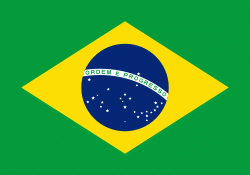Viamão
 |
 |
The origin of the name Viamão is controversial. The more common explanation is that atop the hills of the region it is possible to see the Guaíba River and its five inlets: Jacuí, Caí, Gravataí, Taquari and Rio dos Sinos, which form an open hand. This is said to have lent the city its name -from the phrase "Vi a mão," meaning, "I saw the hand."
In the 18th century the region of the modern state Rio Grande do Sul was a trade route between the cities Sorocaba and Colônia do Sacramento. Various colonists created cattle ranches and plantations here. In 1725, Cosme da Silveira, a member of Captain João de Magalhães' fleet, settled in the Viamão region. He was joined by Francisco Carvalho da Cunha in 1741, who created the Estância Grande site, where the church of Nossa Senhora da Conceição (Immaculate Conception) would be built. In 1747, the colony was declared a civil parish. With the Spanish invasion of 1766, it became necessary to install a government center for the captaincy. Viamão served as the seat of the governor until 1773. At that time, the seat was transferred to Porto dos Casais (which later became Porto Alegre). In 1880, Porto Alegre became its own separate municipality.
In 1889, with the advent of the Republic and the dissolution of the Municipal Chambers as an executive power, the city elected its first mayor, Lt.-Col. Tristão José de Fraga, who previously served as the president of the above-mentioned Municipal Chambers. The second mayor would be Col. Felisberto Luiz de Barcellos.
The economic importance of the region, for being the first cattle ranch, grew from the commerce and transport of dried meat (charque) and leather to Laguna and São Paulo. The three commercial routes at the time began where Viamão is located today. The main road, the Estrada Real ("Royal Road"), left the city and passed through Vacaria, Lages, Curitibanos, Papanduva, Rio Negro, Campo do Tenente, Lapa, Palmeira, Ponta Grossa, Castro, Piraí do Sul, Jaguariaiva, Itararé and arriving at Sorocaba. Another route was over the coastal regions until Laguna.
Map - Viamão
Map
Country - Brazil
Currency / Language
| ISO | Currency | Symbol | Significant figures |
|---|---|---|---|
| BRL | Brazilian real | R$ | 2 |
| ISO | Language |
|---|---|
| EN | English language |
| FR | French language |
| PT | Portuguese language |
| ES | Spanish language |

















